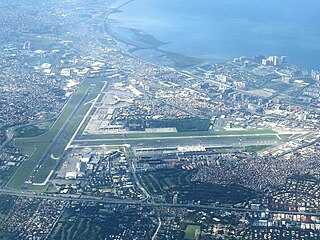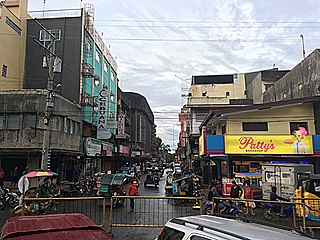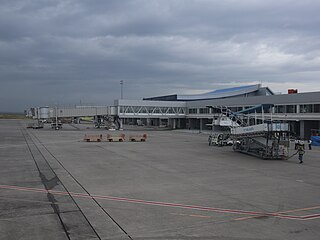
Ninoy Aquino International Airport, originally known as Manila International Airport (MIA), is the main international airport serving Metro Manila in the Philippines. Located between the cities of Pasay and Parañaque, about 7 kilometers (4.3 mi) south of Manila proper and southwest of Makati, it is the main gateway for travelers to the Philippines and serves as a hub for PAL Express, and Philippine Airlines. It is also the main operating base for AirSWIFT, Cebgo, Cebu Pacific, and Philippines AirAsia.

Legazpi Airport(IATA: LGP, ICAO: RPLP) was a major airport in the Bicol Region, served the vicinity of Legazpi, the capital city of Albay in the Philippines.

Dipolog, officially the City of Dipolog, is a 3rd class component city and capital of the province of Zamboanga del Norte, Philippines. According to the 2020 census, it has a population of 138,141 people.

Francisco Bangoy International Airport, also commonly known as Davao International Airport, is the main airport serving Davao City and Davao Region in the Philippines. It is the busiest airport on the island of Mindanao and the third busiest in the Philippines in 2022.

Ozamiz, officially the City of Ozamiz, is a 3rd class component city in the province of Misamis Occidental, Philippines. According to the 2020 census, it has a population of 140,334 people.

Zamboanga International Airport is the main airport serving Zamboanga City in the Philippines. Located on a 270-hectare (670-acre) site in Barangay Canelar, Zamboanga City, the airport is Mindanao's third-busiest airport after Francisco Bangoy International Airport in Davao City and Laguindingan Airport in Laguindingan, Misamis Oriental.

Laguindingan Airport, also referred to as Laguindingan International Airport, is an international airport in Northern Mindanao that serves the cities of Cagayan de Oro, Iligan, and Marawi, as well as the provinces of Misamis Oriental, Lanao del Norte and Bukidnon in the Philippines. The airport is Mindanao's second-busiest airport after Francisco Bangoy International Airport in Davao City.

Godofredo P. Ramos Airport, also known as Caticlan Airport and recently, Boracay Airport by its developer Trans Aire, is an airport serving the general area of the municipality of Malay, located in the province of Aklan in the Philippines. It is one of the two gateways to Boracay, the other being Kalibo International Airport in Kalibo. The airport is classified as a Class 1 principal airport by the Civil Aviation Authority of the Philippines.

General Santos International Airport, also known as Tambler Airport, is an alternate international airport located in the city of General Santos, Philippines serving the greater area of Soccsksargen. Situated in Fatima, General Santos, it is a large airport on the island of Mindanao and is officially classified as an international airport by the Civil Aviation Authority of the Philippines (CAAP), a government bureau which is responsible for the management and operations of General Santos International Airport and all other airports in the country except regular international airports.

Puerto Princesa International Airport is an airport serving the general area of Puerto Princesa, located in the province of Palawan in the Philippines. It is classified as an international airport by the Civil Aviation Authority of the Philippines.

Kalibo International Airport is an international airport that serves the general area of Kalibo, the capital of the province of Aklan in the Philippines, and is one of two airports serving Boracay, the other being Godofredo P. Ramos Airport in the municipality of Malay. It is the fastest growing airport in the Philippines in terms of passenger traffic with more than 50% growth in 2010, and 2nd fastest for seats offered for June 2014 over the corresponding month of the previous year (20%). The airport is classified as an international airport by the Civil Aviation Authority of the Philippines, a body of the Department of Transportation responsible for the operations of all airports in the Philippines except major international airports.

Pagadian Airport, classified Principal Airport Class 1 or major domestic by the Civil Aviation Authority of the Philippines (CAAP), is an airport serving the city of Pagadian, the rest of the province of Zamboanga del Sur, and the province of Zamboanga Sibugay in the Philippines. The CAAP is the arm of the Department of Transportation which operates all the airports in the Philippines except the major international airports.

Bancasi Airport, also known as Butuan Airport, is an airport serving the general area of Butuan and Agusan del Norte. It is the only airport in Agusan del Norte and the largest in Caraga. The airport is classified as an International Airport by the Civil Aviation Authority of the Philippines (CAAP), a body of the Department of Transportation (DOTr) that is responsible for the operations of not only this airport but of all the other airports in the Philippines, except the major international airports.

Sanga-Sanga Airport, also known as Tawi-Tawi Airport, is an airport serving the general area of Bongao, the capital of the province of Tawi-Tawi in the Philippines. The airport is classified as a Class 2 principal airport by the Civil Aviation Authority of the Philippines (CAAP), a body of the Department of Transportation (DOTr) that is responsible for the operations of not only the airport but also of all other airports in the Philippines except the major international airports. It is not an international airport, contrary to its classification by the Tawi-Tawi provincial government. It is located in Sanga-Sanga Island. The airport was formerly referred by the IATA with the code SGS until the end of 2011, when its IATA code was finally changed to TWT.

Labo Airport, also known as Ozamiz Airport, is an airport serving the general area of the city of Ozamiz in the Philippines. It is the only airport in the province of Misamis Occidental. The airport is classified as a community airport by the Civil Aviation Authority of the Philippines, a body of the Department of Transportation that is responsible for the operations of not only this airport but also of all other airports in the Philippines except the major international airports. It is one of only two community airports in the Philippines with commercial operations, but one of the busiest in Mindanao in terms of aircraft movement and passenger traffic.
Air Philippines Corporation, operating as PAL Express and formerly branded as Air Philippines and Airphil Express, is a wholly-owned subsidiary airline of Philippine Airlines. It is PAL's regional brand, with services from its hubs in Manila, Clark, Cebu, and Davao.

Bohol–Panglao International Airport, also known as New Bohol International Airport, is an international airport on Panglao Island in the province of Bohol, Philippines. The airport opened on November 28, 2018 after decades of planning and three years of construction, replacing Tagbilaran Airport to support Bohol's increased passenger traffic due to tourism. The airport serves as the gateway to Tagbilaran and the rest of mainland Bohol for domestic air travellers. It also is less than an hour's flight from Mactan–Cebu International Airport, which is a gateway to central Philippines for international tourists.
Aero Majestic Airways, Inc. is a Filipino passenger airline, air charter operator and aircraft maintenance provider based at Zamboanga International Airport in Zamboanga City, Philippines. It is the only Mindanao-based commercial airline operating in the Philippines.

Bacolod–Silay International Airport, is an airport serving the general area of Metro Bacolod, located in the Western Visayas region of the Philippines.

Mactan–Cebu International Airport is an international airport serving Cebu and serves as the main gateway to the Central Visayas region in the Philippines. Located on a 797-hectare (1,970-acre) site in Lapu-Lapu City on Mactan, it is the second busiest airport in the Philippines. Opened on April 27, 1966, the airport serves as a hub for Philippine Airlines, and as an operating base for Cebu Pacific and Philippines AirAsia.




























